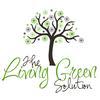A while ago a friend of mine asked me about mold. Apparently he was getting mold in the bedroom and didn’t know how to eradicate the problem safely and prevent it from happening again. Unfortunately (or fortunately), I haven’t had much dealings with mold. The only time I’ve ever come face-to-face with it is after leaving cheese in the refrigerator too long. Not exactly the same type of mold he was referring to. However, I am familiar with how toxic it can be, having had a friend in Phoenix evacuate her home because of a very severe black mold problem. It was so bad, both her and her husband were forced out of their home for months while crew in hazmat suits took over and demo’d their entire kitchen down to the frame. It was a horrible story and one I hope I never have to tell myself.
What is Mold?
Mold is a natural part of the environment. In nature molds break down dead and decaying material. In indoor environments, they can cause structural damage because they consume and destroy the material they settle upon. They can produce allergens, respiratory irritants and also cause toxic substances called mycotoxins.
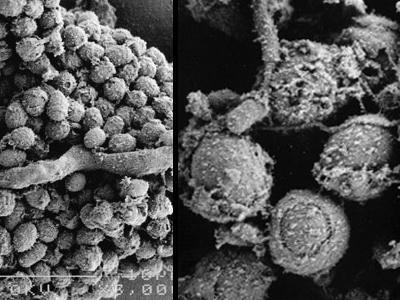
Mold magnified
What Causes Mold?
Molds need moisture to grow. It thrives where conditions are wet or damp. Some household situations that lead to mold growth include:
- Clogged gutters and downspouts
- Leaky plumbing or drainage problems
- Leaky roofs
- Flooding
- Damp basements and crawl spaces
- Steam from the bathroom or kitchen
- Condensation resulting from poor or improper insulation or ventilation
- Humidifiers
- Wet clothes drying inside the home or a clothes dryer venting indoors
- Poor or improper ventilation of combustion appliances
Also, when indoor air is warmer than outdoor air, moisture can collect on cold surfaces like single-pane windows, uninsulated walls, pipes and roofs.
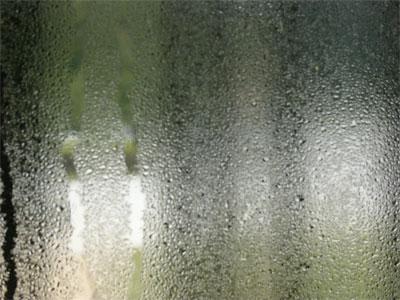
Condensation
What are Symptoms of Mold Exposure?
Allergy and irritation are the most common symptoms of mold exposure. Although symptoms will vary, the most common symptoms seen in people exposed to mold indoors include:
- Asthma
- Sneezing
- Nasal and sinus congestion
- Eye irritation, such as itchy, red, watery eyes
- Respiratory problems, such as wheezing and difficulty breathing
- Cough
- Throat irritation
- Skin irritation, such as a rash
- Headache
People with sensitive respiratory systems or a repressed immune system, children, elderly and pregnant women are more likely to experience problems from mold.
How Do I Know if I Have a Mold Problem?
Indications of a moisture problem may include discoloration of the ceiling or walls, warping of the floor, or condensation on the walls or windows or slimy patches that increase in size as they grow. They also produce a musty, earthy or foul smell.
The best way to find mold is to examine areas for any visible signs of mold growth such as water staining or follow the foul smell to the source. It may be necessary to look underneath surfaces such as carpets, wallpaper, walls or cabinets.
Molds grow in almost every place of the house and some places are more susceptible than others to mold growth. These include:
- Shower curtains
- Window moldings
- The seal on the refrigerator door
- Surfaces on and around the air conditioner
- The shower stall and tiles
Other places to look include the bathroom, basement, furniture cushions, indoor plant soil, and mattresses.
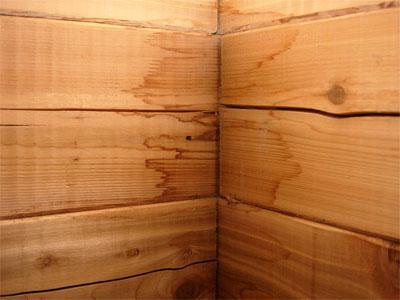
Water Stains
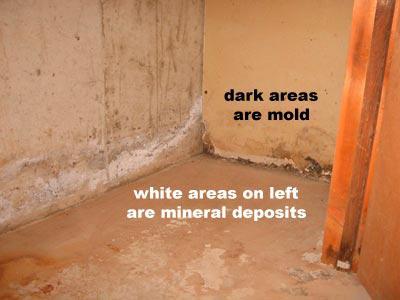
Water in the ground has seeped through the concrete walls of the basement, leaving white mineral deposits on the walls. The water has evaporated into this basement, increasing humidity. Mold is growing in some areas.
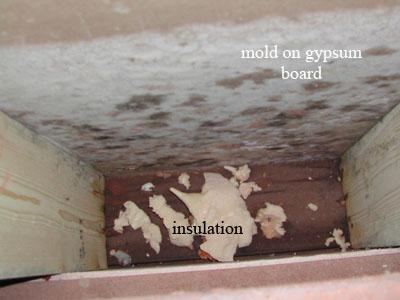
Inside of wall from above, moldy gypsum board, insulation.
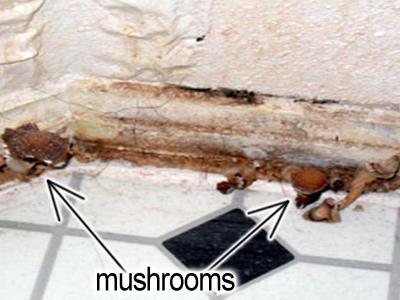
Mushrooms growing at the base of and behind the baseboard below a water leak in a bathroom. The baseboard has been removed; the puckers in the paint are due to water damage.
Mold Prevention
The key to mold control is moisture control. If mold is a problem in your home, clean up the mold and fix the water problem.
- Make sure the ground slopes away from your house foundation, so that water doesn’t seep into the basement or crawlspace. If water puddles around the foundation after a heavy rain, you may have a problem.
- Keep indoor humidity at 30 to 60 percent. Some programmable thermostats have a built in humidity reading.
- Use air conditioners and/or dehumidifiers to reduce moisture in the air. They’re best when used during humid months and in damp spaces such as basements.
- Use (fully functional) exhaust fans (vented to the outside) to pull indoor moisture (from cooking, dishwashing, showering and laundering) outside. Also be sure to cover your food when cooking so steam does not escape.
- Inspect and repair your ventilation system.
- Increase air circulation by moving furniture at least one inch away from the walls.
- Remove carpeting in areas where there is ongoing moisture (from cooking, sinks, bathtubs and showers).
- Install double-pane windows or insulation to keep moisture from collecting on cold surfaces.
- Regularly clean areas that have been affected by mold to prevent growth and remove mold immediately if it grows.
- Inspect and repair leaks in roofs, gutters, walls, foundations and plumbing.
- To circulate your indoor air and improve the quality of your indoor air, open windows five to ten minutes a day.
How to Remove Mold
To remove mold growth, try one of these non-toxic methods:
- Unlike chemical-based cleaners, white distilled vinegar is natural, green, inexpensive, won’t irritate your lungs, and kills over 80% of all mold! Spray the area with one part water and one part white distilled vinegar. Let it dry and wipe clean. Repeat if necessary. White distilled vinegar is a staple upon green cleaners and is one that I keep in the pantry, in bulk.
- Spray the area with a mixture of two teaspoons of tea tree oil to two cups of water. Let it dry and wipe clean. Tea tree oil can be expensive, but it’s very potent and it has many uses. It also has a strong smell, but it will fade in just a couple of days.
- Spray the area with one part hydrogen peroxide and two parts water. Let it dry and wipe clean. Hydrogen peroxide is another great green cleaning ingredient that is commonly used because of it’s antibacterial and natural whitening properties.
Anytime you’re removing mold, always be sure to wear gloves and a face mask. Also be sure to properly label the mixtures above and save it for the next time you have a mold problem.
NOTE: If the area is larger than three feet by three feet, call a professional. And, never paint over mold as it doesn’t prevent, stop or remove the problem.
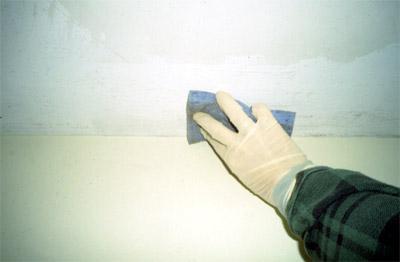
For more information, visit the Environmental Protection Agency for an extensive guide to mold, moisture and your home.
{image credit: © All Rights Reserved Environmental Protection Agency}
